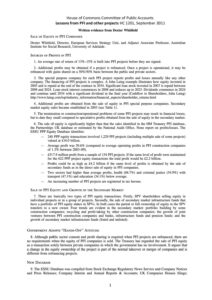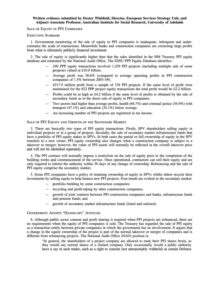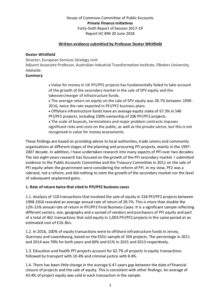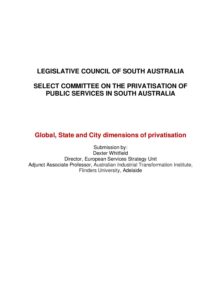Sale of Equity in PFI companies, Written evidence to House of Commons Committee of Public Accounts, June 2011
House of Commons Committee of Public Accounts
Lessons from PFI and other projects
Report, together with formal minutes, oral and written evidence
HC 1201 – 1 September 2011
chrome-extension://efaidnbmnnnibpcajpcglclefindmkaj/viewer.html?pdfurl=https%3A%2F%2Fpublications.parliament.uk%2Fpa%2Fcm201012%2Fcmselect%2Fcmpubacc%2F1201%2F1201.pdf&clen=1068056&chunk=true
The Committee conclusions and recommendations included:
“The Treasury was unable to confirm the extent to which parties involved with PFI contracts were paying UK tax and whether the companies holding PFI contracts were paying UK corporation tax.”
“Tax revenue is being lost through the use of off-shore arrangements by PFI investors and the effect has not been adequately assessed. The Committee is concerned that the Treasury has no plans to address this matter. Some PFI investors reduce their exposure to UK tax through off-shore arrangements. Yet the Treasury assume tax revenue in their cost-benefit analysis of PFI projects. The
Treasury could not tell us if PFI investors had paid tax in the UK on profits and on equity gains, or whether corporation taxes had been collected from PFI companies. The Treasury should measure the tax revenues from PFI deals and should ensure that this is taken into account in future assessments of PFI against conventional procurement.”
“The public sector has insufficient information on the returns made by PFI investors and no mechanism for sharing in gains when the investors sell their shares. Partial information we have seen suggests initial investors can quickly make high profits from selling on their shares in PFI projects, indicating that the taxpayer may be getting a poor deal in the original PFI contracts. The Treasury should introduce arrangements for sharing gains on the sale of PFI equity shares in new PFI
projects. We consider there is also a case for a code of conduct for sharing gains from share sales in existing contracts.”
Sale of Equity in PFI companies
Written evidence to House of Commons Treasury Committee, June 2011
Private Finance Initiative, Volume ll Additional written evidence Ev w121 – Ev w127
The Committee conclusions and recommendations are included in:
House of Commons Treasury Committee
Private Finance Initiative
HC 1146 – August 2011
chrome-extension://efaidnbmnnnibpcajpcglclefindmkaj/viewer.html?pdfurl=https%3A%2F%2Fpublications.parliament.uk%2Fpa%2Fcm201012%2Fcmselect%2Fcmtreasy%2F1146%2F1146.pdf&clen=1710981&chunk=true
Evidence Prof. Dexter Whitfield to:
House of Commons Committee of Public Accounts
Private Finance Initiatives
Report HC 894 – 20 June 2018
chrome-extension://efaidnbmnnnibpcajpcglclefindmkaj/viewer.html?pdfurl=https%3A%2F%2Fpublications.parliament.uk%2Fpa%2Fcm201719%2Fcmselect%2Fcmpubacc%2F894%2F894.pdf&clen=264352&chunk=true
The Committee conclusions and recommendations included:
“Offshore funds have bought up about half of the equity in PFI and PF2 projects so that the projects’ owners are increasingly remote from the public service being delivered. In addition, offshore owners of these projects pay little tax, thereby reducing one of the benefits used to justify the contracts in the first place.
Add to this the additional costs (and profits) generated by variations to the contract and the deal is not working for the taxpayer.”
“Some private investors have made large returns from PFI deals, suggesting that departments are overpaying for transferring the risks of projects to the private sector, one of the Treasury’s stated benefits of PFI. Private investors expect a financial return as reward for taking on risks transferred to the private sector under PFI deals. Investors in the M25 PFI deal made an estimated annual return of over 30% after selling their stake in the project after 8 years, more than double the 12%–15% annual returns expected over the life of most PFI deals. Equity returns this large may reflect errors in the pricing of risk transfer to the private sector at the time contracts were signed. We previously recommended that the Treasury should introduce arrangements to share the profits from PFI deals between private investors and the public sector, which the Treasury rejected. It instead sought to limit excessive returns to investors through equity funding competitions, which are relatively untested, and do nothing about the rate of returns from the existing stock of PFI projects. We received written evidence from Professor Whitfield, Director of the European Services Strategy Unit, who told us that offshore infrastructure funds owned around half of the equity in PFI and PF2 projects, with the five largest of these offshore funds paying less than 1% in tax on their PFI profits. The Treasury told us that public procurement rules prevent discrimination against non-UK domicile investors. The amount of tax an investor pays is relevant, however, because the assessment of whether a prospective PFI deal is likely to provide value for money should include the corporation tax an investor is expected to pay as a benefit of PFI. The assessment may therefore overstate the benefits of the deal, and could lead to an incorrect value for money decision, if equity is subsequently purchased by offshore investment funds and corporation tax receipts are lower as a result.”
“Recommendation: The Treasury should calculate the returns to originating PFI equity investors when they sell on their stake and use the information to inform pricing for future projects. This should include the domicile of project equity holders, and what impact a reduced tax take would have had on the original project value for money tests.”
“In written evidence, Professor Dexter Whitfeld, Director of the European Services Strategy Unit, told us that returns to investors in excess of 25% are not uncommon in PFI projects. His analysis of 118 transactions that involved the sale of equity revealed an average return to investors of 28.7%. Equity returns this large may reflect errors by departments in their pricing of risk transfer to the private sector at the time they entered into the contracts. We examined equity returns in 2010 and concluded that excessive gains may indicate overpriced PFI contracts.
The previous Committee suspected in 2011 that initial investors were able to make excessive profits from selling PFI shares, but lacked the information to be sure. It believed that there was a strong case for sharing these gains with the government. The Committee recommended that the Treasury should introduce arrangements for sharing in investors’ gains. The Treasury partially accepted this recommendation saying that consideration would be given to the sharing of gains from PFI equity investors. However, the Treasury told us that it had decided against introducing sharing arrangements, despite other countries using such arrangements. Instead the Treasury sought to address the problem by introducing equity funding competitions.38 These competitions are intended to drive down the price of equity by creating competitive tension between bidders seeking to invest in a portion of the project equity. Government has only used an equity funding competition in one PF2 deal to date, and while this successfully resulted in lowering the returns to equity investors, the approach is relatively untested. Moreover, the changes only affect future PF2 deals, and do nothing about excessive returns investors can make on the historic stock of over 700 projects. The public sector will also invest as minority equity stake in all future PF2 deals, which should increase transparency to these returns as the public sector will have a seat on the PFI provider’s Board.
We were concerned to hear of high profile cases where the equity element of PFI contracts have been sold to offshore investment funds that pay little or no corporation tax in the UK, which we first drew to the Treasury’s attention in 2011.42 The previous Committee highlighted the potential for tax avoidance through the sale of equity in the secondary market to investors non-domiciled in the UK.43 The Treasury told us that, while the vast majority of PFI companies are UK tax domiciled and pay corporation tax, public procurement rules prevent discrimination against non-UK domiciled companies and investors.44 As a result, the Treasury cannot control where secondary PFI investors are located, and can only take action if there is evidence of inappropriate tax evasion.45 Professor Whitfield told us that offshore infrastructure funds owned around half of the equity in PFI and PF2 projects, with the five largest offshore infrastructure funds making profits of £2.9 billion in the 5 year period between 2001–2017, and paying less than 1% in tax on their PFI profits.46 The Treasury’s rules require departments to undertake a value for money assessment of a PFI or PF2 deal, and the amount of corporation tax a private company is expected to pay is one component of this. The higher the amount that the company is expected to pay, the more likely that the PFI option will be judged value for money. These tax adjustments have historically been criticised for being too high.47 If the calculations do not reflect the reality that offshore investors dominate the secondary market, then the estimated benefits will be overstated.48 We were concerned that this could lead to an incorrect conclusion that the PFI or PF2 deal offers better value than the project being financed by the public sector.”
Legislative Council of South Australia
Select Committee on the privatisation of public services in South Australia 2021
Evidence submitted: Global, state and city dimensions of privatisation
Prof. Dexter Whitfield, July 2021





